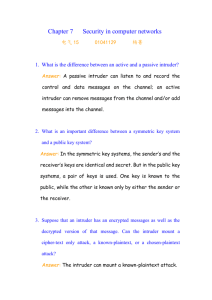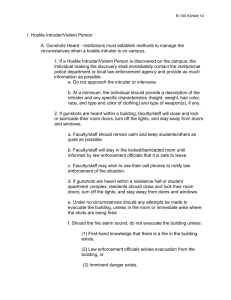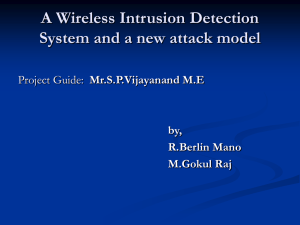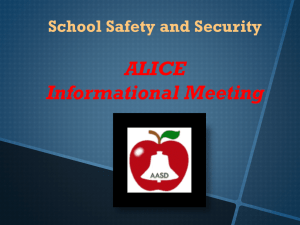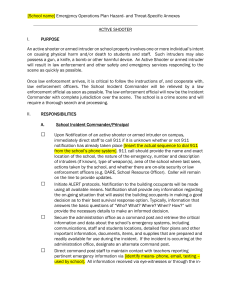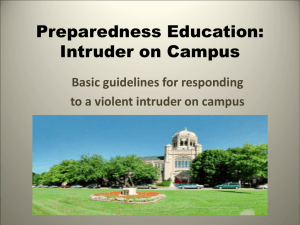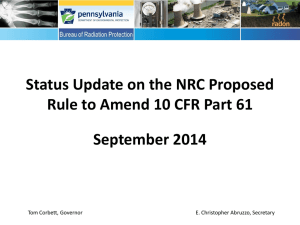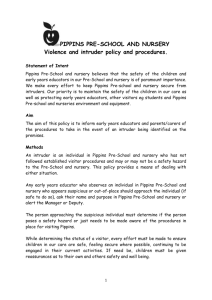Armed Intruder Protocol - Office of Catholic Education
advertisement
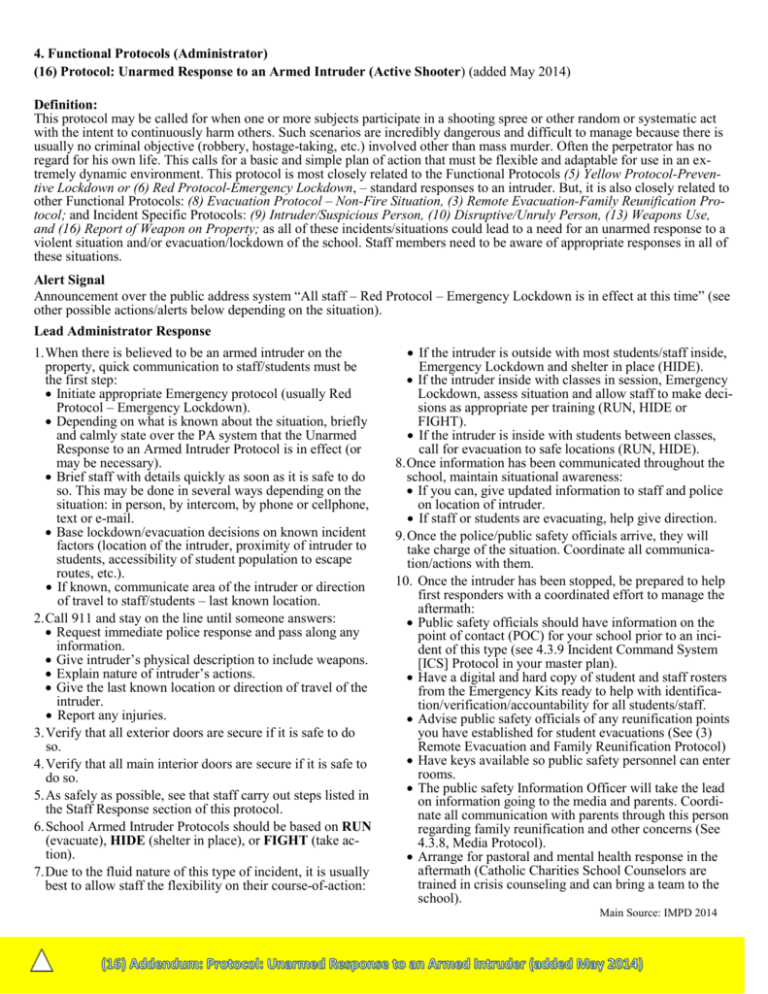
4. Functional Protocols (Administrator) (16) Protocol: Unarmed Response to an Armed Intruder (Active Shooter) (added May 2014) Definition: This protocol may be called for when one or more subjects participate in a shooting spree or other random or systematic act with the intent to continuously harm others. Such scenarios are incredibly dangerous and difficult to manage because there is usually no criminal objective (robbery, hostage-taking, etc.) involved other than mass murder. Often the perpetrator has no regard for his own life. This calls for a basic and simple plan of action that must be flexible and adaptable for use in an extremely dynamic environment. This protocol is most closely related to the Functional Protocols (5) Yellow Protocol-Preventive Lockdown or (6) Red Protocol-Emergency Lockdown, – standard responses to an intruder. But, it is also closely related to other Functional Protocols: (8) Evacuation Protocol – Non-Fire Situation, (3) Remote Evacuation-Family Reunification Protocol; and Incident Specific Protocols: (9) Intruder/Suspicious Person, (10) Disruptive/Unruly Person, (13) Weapons Use, and (16) Report of Weapon on Property; as all of these incidents/situations could lead to a need for an unarmed response to a violent situation and/or evacuation/lockdown of the school. Staff members need to be aware of appropriate responses in all of these situations. Alert Signal Announcement over the public address system “All staff – Red Protocol – Emergency Lockdown is in effect at this time” (see other possible actions/alerts below depending on the situation). Lead Administrator Response 1. When there is believed to be an armed intruder on the property, quick communication to staff/students must be the first step: Initiate appropriate Emergency protocol (usually Red Protocol – Emergency Lockdown). Depending on what is known about the situation, briefly and calmly state over the PA system that the Unarmed Response to an Armed Intruder Protocol is in effect (or may be necessary). Brief staff with details quickly as soon as it is safe to do so. This may be done in several ways depending on the situation: in person, by intercom, by phone or cellphone, text or e-mail. Base lockdown/evacuation decisions on known incident factors (location of the intruder, proximity of intruder to students, accessibility of student population to escape routes, etc.). If known, communicate area of the intruder or direction of travel to staff/students – last known location. 2. Call 911 and stay on the line until someone answers: Request immediate police response and pass along any information. Give intruder’s physical description to include weapons. Explain nature of intruder’s actions. Give the last known location or direction of travel of the intruder. Report any injuries. 3. Verify that all exterior doors are secure if it is safe to do so. 4. Verify that all main interior doors are secure if it is safe to do so. 5. As safely as possible, see that staff carry out steps listed in the Staff Response section of this protocol. 6. School Armed Intruder Protocols should be based on RUN (evacuate), HIDE (shelter in place), or FIGHT (take action). 7. Due to the fluid nature of this type of incident, it is usually best to allow staff the flexibility on their course-of-action: If the intruder is outside with most students/staff inside, Emergency Lockdown and shelter in place (HIDE). If the intruder inside with classes in session, Emergency Lockdown, assess situation and allow staff to make decisions as appropriate per training (RUN, HIDE or FIGHT). If the intruder is inside with students between classes, call for evacuation to safe locations (RUN, HIDE). 8. Once information has been communicated throughout the school, maintain situational awareness: If you can, give updated information to staff and police on location of intruder. If staff or students are evacuating, help give direction. 9. Once the police/public safety officials arrive, they will take charge of the situation. Coordinate all communication/actions with them. 10. Once the intruder has been stopped, be prepared to help first responders with a coordinated effort to manage the aftermath: Public safety officials should have information on the point of contact (POC) for your school prior to an incident of this type (see 4.3.9 Incident Command System [ICS] Protocol in your master plan). Have a digital and hard copy of student and staff rosters from the Emergency Kits ready to help with identification/verification/accountability for all students/staff. Advise public safety officials of any reunification points you have established for student evacuations (See (3) Remote Evacuation and Family Reunification Protocol) Have keys available so public safety personnel can enter rooms. The public safety Information Officer will take the lead on information going to the media and parents. Coordinate all communication with parents through this person regarding family reunification and other concerns (See 4.3.8, Media Protocol). Arrange for pastoral and mental health response in the aftermath (Catholic Charities School Counselors are trained in crisis counseling and can bring a team to the school). Main Source: IMPD 2014 5. Functional Protocols (Faculty and Staff) (16) Protocol: Unarmed Response to an Armed Intruder (Active Shooter) (added May 2014) Definition: This protocol may be called for when one or more subjects participate in a shooting spree or other random or systematic act with the intent to continuously harm others. Such scenarios are incredibly dangerous and difficult to manage because there is usually no criminal objective (robbery, hostage-taking, etc.) involved other than mass murder. Often the perpetrator has no regard for his own life. This calls for a basic and simple plan of action that must be flexible and adaptable for use in an extremely dynamic environment. This protocol is most closely related to the Functional Protocols (5) Yellow Protocol-Preventive Lockdown or (6) Red Protocol-Emergency Lockdown, – standard responses to an intruder. But, it is also closely related to other Functional Protocols: (8) Evacuation Protocol – Non-Fire Situation, (3) Remote Evacuation-Family Reunification Protocol; and Incident Specific Protocols: (9) Intruder/Suspicious Person, (10) Disruptive/Unruly Person, (13) Weapons Use, and (16) Report of Weapon on Property; as all of these incidents/situations could lead to a need for an unarmed response to a violent situation and/or evacuation/lockdown of the school. Staff members need to be aware of appropriate responses in all of these situations. Alert Signal (6) Red Protocol – Emergency Lockdown is usually the standard response to an intruder although there may be another signal. In an armed intruder situation, staff may not receive an alert from the office and may need to act on their own according to plan and training. Staff Response Be aware of your environment and have a simple plan on the course-of-action you will take to evade an intruder. Depending on the age and needs of students in your charge, your choices as to course-of-action may be limited. 1. RUN If you see or hear of an armed intruder or learn that the intruder is in another part of the building, your first option may be to RUN (evacuate the area) with your charges. Have students leave their belongings and move as quickly as possible to a safer area. If you come across others who do not know what to do, help them escape as well. Prevent others from entering the area you have left. When you reach safety, call 911 and stay on the line until someone answers: o Request immediate police response and pass along any information. o Give intruder’s physical description to include weapons. o Explain nature of intruder’s actions. o Give the last known location or direction of travel of the intruder. o Report any injuries. If you cannot escape safely… 2. HIDE If the intruder is blocking the escape, the next action is to HIDE (shelter-in-place) with your students: If possible, go to a pre-designated place that can be secured out of the view of the intruder. Lock all doors and/or blockade doors with furniture. Turn out lights and close curtains/blinds if possible. Keep low and away from windows. Stay quiet (silence cell phones and other devices including phones on vibrate). Try to find protection behind furniture, walls, etc. from shots fired in your direction. If possible, try not to restrict options for movement. Remain very quiet, but call 911 when it is safe to do so (see above). Be prepared to take action if the intruder enters your hiding place… 3. FIGHT If you have tried to run and have been stopped or if the intruder enters your hiding place, your last option is to FIGHT. Gather people together and form a simple plan of attack to overpower the intruder by whatever means possible – this could save lives! Look for objects that could help you fight and injure the intruder. Improvise weapons from everyday objects. Use whatever you can find that may incapacitate or disarm the intruder. Act with physical aggressiveness. Commit to your actions! 4. POLICE RESPONSE The police will respond in force. They are trained to respond directly to this type of threat. Their first objective is to stop the threat. Therefore … Police will not attend to the injured or evacuate the innocent until their objective is met. Most active shooter situations last only eight minutes or less. However, it may be a long time before the police/public safety officials are able to identify verify and account for everyone and evacuate them from the school. When evacuated: o Everyone is considered unknown until police have control of the scene. o Keep hands visible. o Do not point objects at or reach out to officers. o Try to remain calm. Main Source: IMPD 2014
